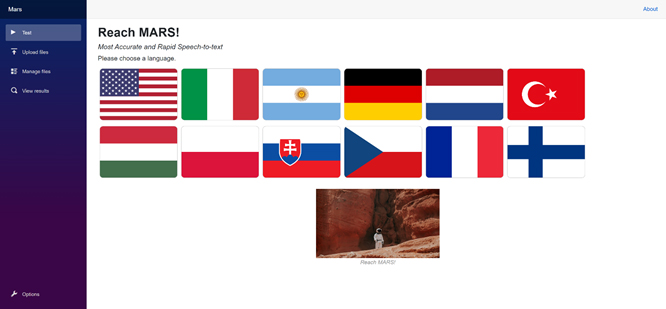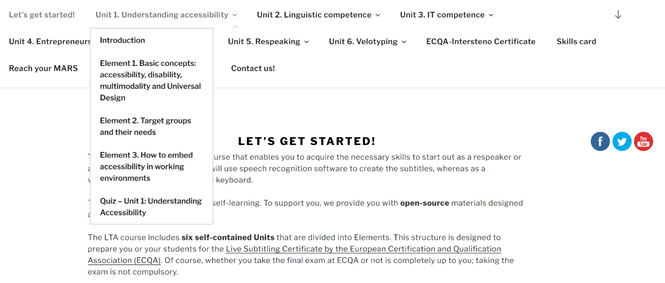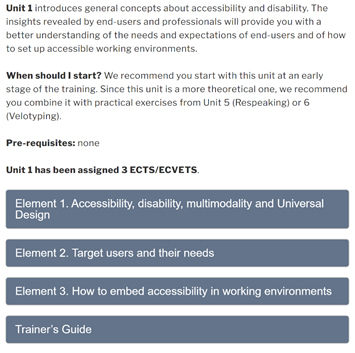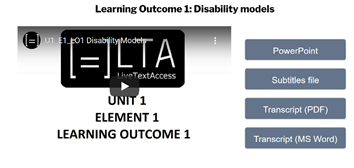Introduction
Real-time intralingual subtitling services have become more and more significant since the adoption of the Convention on the Rights of Persons with Disabilities in 2006. Training programmes started to be offered both in higher and vocational education and in in-house contexts to meet the increasing demand for qualified and trained experts. Still, training courses often focus on a single technique, either respeaking or keyboard-based subtitling, or on a single working context, such as TV (Eugeni, & Bernabé 2019). Similarly, other settings are left out, such as education and workplace settings. As a result, end users have to deal with uneven quality (European Federation of Hard of Hearing People [EFHOH] 2015), and professionals willing to acquire new necessary skills are bound to be self-taught.
This article reports on how the EU co-funded project LiveTextAccess (LTA: www.ltaproject.eu) has contributed to harmonize training for real-time intralingual subtitling in multiple contexts by providing an open-source modular course for respeakers and velotypists, as well as the Intersteno-ECQA certificate. In this short article, we describe how to start the training depending on trainees’ initial proficiency level (i.e. basic, intermediate or advanced), the pre-requisites, types of materials, and possibility of taking the certification exam.
The project and its outputs
LiveTextAccess has been an Erasmus+ project that ran from September 2018 to August 2021. The strategic partnership included three universities (SDI München, Universitat Autònoma de Barcelona, and the Scuola Superiore per Mediatori Linguistici di Pisa), two accessibility service providers (Sub-Ti Access and Velotype), one broadcasting company (ZDF Digital), one certification association (the European Certification and Qualification Association [ECQA]) and one end-user association (the EFHOH).
The project implemented five working packages that led to five main outputs:
- an overview of current training and professional practice situation in Europe (IO1);
- a skills card for respeakers and velotypists (IO1);
- a modular curriculum (IO2);
- open-source learning materials (IO3) for a 30 ECTS/ECVETS course;
- and a certificate (IO5).
You can read more about IO1 and IO2 in another article published in TIRO (Bernabé & Oncins 2020). The reports of all the outputs are available on the LTA projects web page.
The 30 ECTS course: techniques, materials and certificate
One of the main aims of the LTA project was to create an open-source training programme and materials. The LTA course is a self-paced course that enables trainees to acquire the necessary skills to start out as a respeaker or as a velotypist and to practise in five working contexts, i.e. live TV, cultural events, working meetings, work settings, education, and parliamentary assemblies. The modular structure encompasses six self-contained Units, which are divided into Elements, and into Learning Outcomes, or LOs. This modularity enables prospective trainers and trainees to create own personalized courses that build on their skillset from the first day onwards.
Before entering the training, several decisions must be made. The first is about the technique, i.e. respeaking or velotyping. To facilitate the process, there is an explanatory video (https://youtu.be/ZqBf0wlcnz8). The second decision concerns the organization of the learning process based on two aspects: a) the technique and b) the initial proficiency level. The videos for the respeaking and velotyping training tracks provide an overview of the expected requirements for each level (i.e. basic, intermediate, and advanced), the duration of training and the expected outcomes. For instance, if you are already an advanced respeaker, and want to undergo the LTA course, you can skip the beginner and intermediate levels of the respeaking Unit and only focus on the LOs for the advanced level, while gaining knowledge of the general Units. This information can be found in the so-called Track videos (for respeaking: https://youtu.be/AGRvmRxBS20; for velotyping: https://youtu.be/0sKAxPC7A4w) and in the trainer’s guide of each Unit (see below).
The LTA course is also designed for trainers. The main documents for trainers, apart from the training materials, are the Trainer’s Guides for each Unit, the reading list, and the online MARS tool. The Trainer’s Guide of the Unit contains useful information and additional materials, such as the level of proficiency defined for each LO, i.e. basic, intermediate or advanced, peri-assessment questions to practise during training, and a reading list with recommended literature. The MARS-Tool, on the other hand, is an online free training space created to help students train and assess their accuracy when creating subtitles (Picture 1). The multilingual tool is available at reachmars.eu and is also used for the Intersteno-ECQA exam.

How to navigate through the online course and the materials
The organisation of the LTA course on the webpage is very straightforward. The main menu items show an introduction page called “Let’s get started!” followed by the Units, as shown in Picture 2.

All Units follow the same structure both in the menu and within the Unit itself. The menu item for the Units enables access to the Introduction to the Unit, the Elements and the Quiz, as shown in Picture 3.

When clicking on a Unit, the Introduction video to the Unit appears followed by key information about the Unit, such as the overall topic, the number of credits, the prerequisites and a recommendation about when to start the Unit. Finally, a series of buttons to the Unit’s Elements and the Trainer’s Guide appear, as shown in Picture 4.

Once the user has selected an Element, the training materials appear. The materials in each Element are ordered by Learning Outcome. For each video lecture, trainees are also provided with the transcript in two formats, the subtitles file, and the presentation with the exercises. It is possible to download or to open the materials online (Picture 5).

Additionally, the Unit’s menu gives access to short quizzes that can be taken numerous times and give automatic feedback.
The trainers in the video lectures are the LTA partners and external collaborators, whose contributions enriched the training content with their insights from the world of job and their languages, as is the case, for example, in the 14 videos about basic expressions in Sign language from 14 different countries (https://youtube.com/playlist?list=PL7qhCLtDxsd9_eyupj2yo6IcwjspTFqDT).
The Intersteno-ECQA certification and exam
The last IO is dedicated to the creation of the ECQA/Intersteno certificate and exam for the job roles of real-time intralingual subtitler through respeaking or velotyping. The idea behind the certification is that some professionals or organizations would like to have their skills validated by a third party. This is sometimes a hiring requirement and often an admission requirement in education.
The exam is organised by ECQA and has three parts: a test consisting of multiple-choice questions, an interview with the exam committee and a practical subtitling part using the MARS tool. For the exam, partners have developed a total of 198 exam questions.
Lastly, another output of IO5 is a self-assessment test, which can be taken prior starting the course or at a later stage, for instance, after the trainee has undergone some training to evaluate his or her progress. The test is open-source and includes 66 multiple-choice questions. The self-assessment questions are freely available on the ECQA platform.
Any training body, including universities that want to become ECQA Certified Training and Exam Organizations, needs to fill in and sign an application form and a contract with ECQA. In fact, in May 2021, Intersteno signed an agreement with ECQA to become a Certifying Exam Organization. This was a milestone reached by LTA, since the practical parts of the LTA exams can now also be offered during high-level Intersteno conferences.
Conclusions
The EU co-funded project LiveTextAccess started in 2018 with the objective of harmonizing training for real-time intralingual subtitling in multiple contexts. The primary added value has been the delivered tangible results, which are ready-to-use and can be personalized according to the training context, participants, and technique. Similarly significant has been the open international network of stakeholders built during the past three years, which will hopefully remain strong in the future.
Nonetheless, there is still plenty of work to be done. For instance, future courses and projects could also include training materials dedicated to artificial intelligence and computer-aided systems. In addition, at a professional level, there is still a need for a digital space that can enable any service provider, private person or national agency to contact or find real-time subtitlers across Europe and beyond its borders. Lastly, at a certification level, leading countries in this field, such as Spain, Great Britain or Germany, could create a programme or scheme to recognize certificates Europe-wide and internationally.
Piero Cavallo holds an MA in Linguistic, Literary and Translation Studies. He is a guest researcher at the International University SDI München, in Germany. piero.cavallo@sdi-muenchen.de
Dr. Rocío Bernabé Caro is the deputy Head of the Professional College of Translation and Interpreting of the Internationale Hochschule SDI in Munich, Germany. rocio.bernabe@sdi-muenchen.de
References
Bernabé Caro, R. & Oncins, E. (2020). Harmonized Training in Real-Time Intralingual Subtitling. – Tiro 1/2020.
EFHOH. (2015). State of subtitling access in EU: 2015 Report. https://efhoh.org/wp-content/uploads/2017/01/EFHOH-State-of-Subtitling-2015-English.pdf
Eugeni, C., & Bernabé Caro, R. (2019). The LTA project: Bridging the gap between training and the profession in real-time intralingual subtitling. Linguistica Antverpiensia, New Series – Themes in Translation Studies, 18, 87-100. https://doi.org/10.52034/lanstts.v18i0.512




